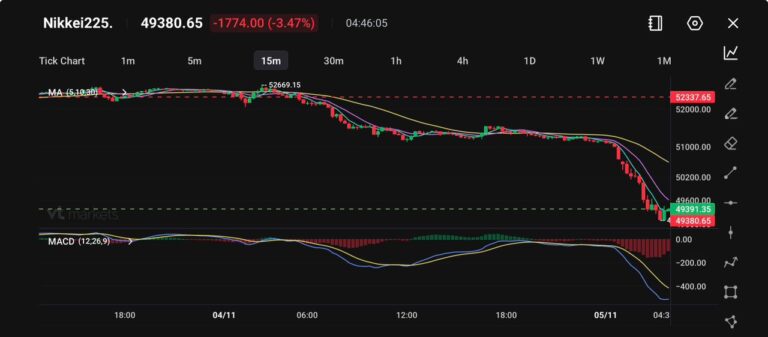Asian equities plunged on Wednesday as investors dumped risk assets following a sharp, tech-driven rout on Wall Street. Japan’s Nikkei 225 slumped 3.47% to 49,380.65, wiping out nearly 7% from Tuesday’s record peak, while South Korea’s KOSPI dropped 6.2% amid heavy selling in chipmakers and AI-related shares.
The sell-off was sparked by renewed concerns over lofty stock valuations after several major Wall Street leaders, including the CEOs of Morgan Stanley, Goldman Sachs, and JPMorgan Chase cautioned that the market’s rapid rally might be unsustainable.
“It’s red across the board,” said Chris Weston of Pepperstone, adding that traders appear reluctant to “buy the dip” ahead of Nvidia’s earnings on 19 November.
Broader Market Moves
The MSCI Asia ex-Japan Index sank 2.3%, marking its steepest one-day drop since early April, when US tariff tensions rattled markets. SoftBank Group tumbled 10%, while other major tech names followed the Nasdaq Composite’s near 2% overnight decline.
In the currency space, the US dollar slipped 0.3% to ¥153.16 after dovish Bank of Japan meeting minutes were released. The US Dollar Index (USDX) also eased after briefly touching a five-month high at 100.25.
Meanwhile, Bitcoin briefly fell below $100,000 for the first time since June before staging a mild recovery, and gold edged up 0.2% to $3,938.54 per ounce following three straight sessions of losses.
Technical Analysis
The Nikkei 225’s sharp 3.5% drop to 49,380.65 erased part of its recent rally, pulling it back beneath the psychological 50,000 threshold. The steep reversal comes after an extended uptrend, signalling potential weakness in the short-term outlook.
Technically, the index broke below recent support levels and short-term moving averages, with the MACD histogram widening on the downside, indicating mounting negative momentum.

From a fundamental viewpoint, the drop is tied to broad-based tech sell-offs in Asia following warnings from major US banks about ‘stretched valuations,’ especially in the semiconductor and AI sectors.
In Japan, exporters were hit doubly by the tech slump and by a stronger yen and more cautious global demand backdrop, undermining the bullish momentum that had driven the Nikkei higher.
Looking ahead, the key things to watch: if the index can hold above the next support near 48,000, there may be a rebound attempt; but if it breaks decisively below that level, a deeper correction toward 46,000–45,000 could be on the cards.
Conversely, for a turnaround, the Nikkei would need a strong close back above 50,000 and a tightening of the MACD spread, ideally driven by fresh catalyst headlines such as improved earnings or positive trade news.
Outlook
The index remains exposed as traders weigh stretched valuations against solid corporate earnings. With volatility reaching its highest since April, investors are likely to stay defensive in the run-up to Nvidia’s results and key US inflation data.
While short-term sentiment remains fragile, longer-term fundamentals, including resilient profit growth and a weak yen, could help steady Japanese equities once the current correction finds its footing.







